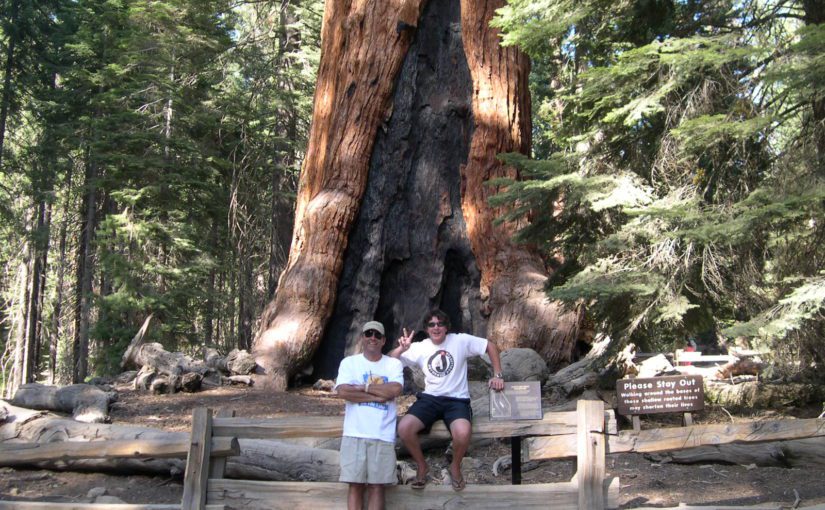The Grizzly Giant is the most renowned giant sequoia in Yosemite National Park. Standing at a solid 209 feet (63.7 m) it is the second largest tree in the Yosemite, and one of the most photographed. You’ll need to take a panorama to capture that in one image!
We can’t know for certain how old this tree is until we are able to count the annual rings in the wood – something we can’t do now without harming the tree. However, based on its diameter in comparison with other trees, researchers estimate that it could be around 2000 to 3000 years old. That’s long enough for this gentle giant to have a story or two to tell.
Ready to visit? Check out these must-know facts about this wonder before you get to meet in person!
The Grizzly Giant Ranked the 26th Largest Tree In the World!
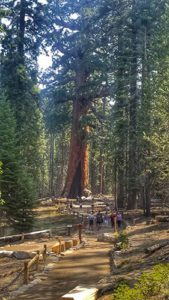
The Grizzly Giant in the Mariposa Grove of Giant Sequoia is a must-see during your Yosemite visit.
In the world of trees, Giant Sequoias (Sequoiadendron giganteum) live up to their name. They are the largest trees in the world by volume. The Grizzly Giant, when measured in 1990, was 34,005 cubic feet (962.9 m3) in volume and roughly 2 million pounds in weight. That’s as heavy as a tower of 145 elephants standing on top of each other.
Even the branches of this mighty tree are noteworthy in their own right. The largest branch growing about 95 feet overhead is more than 6 feet (2 m) in diameter. If it were an independent tree growing out of the ground, just this branch would be much larger than many other non-sequoia trees. However, in context of the massive main trunk, it hardly attracts any notice.
Does that make you feel like a tiny pine cone in comparison? Consider that these massive trees all start their life as a small seed about the size of a flake of oatmeal.
These trees have done a lot of growing already, and unlike us humans, sequoias continue to grow larger with age. Expect generations ahead of us to be even more in awe.
Snag a Front Row Seat for a Sequoia’s Hardiness
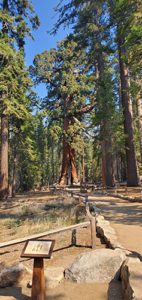
The Grizzly Giant is so massive, it can be hard to get the whole tree in one photo. Best to go see it yourself.
As the Grizzly Giant aged, a snag formed at the top – those dead stems at the top of the tree. This is a feature that many mature giant sequoias share.
What causes those snags?
In its life, likely spanning thousands of years, the Grizzly Giant weathered many hardships that might have been the end of lesser trees. It has likely been hit by lightning more than a few times, and withstood droughts as well as both wind and snow storms.
It’s thick, spongy bark is estimated to be about 2 feet (0.6 m) thick. The tree is filled with tannic acid which increases its resistance to threats from fungus, insects and fire. Still, if you look at the base of the tree, you will notice charred hollows, fire scars that are probably hundreds of years old. The Grizzly Giant survived these lightning fires – a good thing since fires are an essential part of the Sequoia lifecycle. However, fire scars interrupt the flow of water from the roots to the tree tops. When this happens the top of the sequoia dies back to reduce the water requirement, producing a snag top. A new branch can take over as the leader, only to die back again when another fire comes through, or during an extensive drought.
For a giant sequoia, the presence of a snag in the top is a proud banner of its ability to endure across millennia.
The Grizzly Giant Gets A Little Help From Its Friends
As long-lived as giant sequoias are, they couldn’t do it without help from their neighbors. If you walk all the way around the Grizzly Giant, you’ll notice that it has a pronounced lean. The trunk lists almost 5 degrees to the south and 1.5 degrees to the west. Even with the 96.5-foot (29.5 m) circumference at ground level, that puts the roughly 2 million pounds (907 metric tons) of weight decidedly off center.
It looks so precarious that in 1904 supporting cables were proposed to help the Grizzly Giant remain standing. Though the cables were never installed, they have so far been unnecessary.
Do sequoia trees have a secret power that helps keep them upright?
Sequoia root systems don’t plunge deep into the ground with a tap root – instead they reach out to the side, remaining close to the surface. You can see this shallow root system in toppled trees like The Fallen Monarch. As the roots grow out to the side, they interlace with the roots of their neighbors so the trees can help hold each other up.
This shallow root system appears to be one key to the Grizzly Giant’s longevity. It’s also the reason that walking around the base of the tree and compressing the soil around these fragile roots can be so harmful to these ancient trees.
The Coolest Kid in the Grove
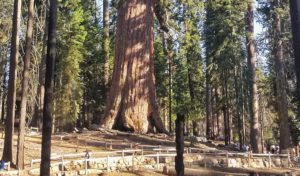
Giant sequoias are not the tallest trees, but they are the most massive trees in the world, and the diameter of these trees is simply jaw-dropping.
The Grizzly Giant Loop is one of the most popular trails in the Mariposa Grove of Giant Sequoias. By now, you can probably see why. Who wouldn’t want to meet the Grizzly Giant in person?
The numbers and photos can’t do justice to this rare and ancient tree. You have to see it in person, tilting your head back – way back – to look into its massive branches, and contemplate all that it has seen in its lifetime.
The Mariposa Grove is home to more than 500 mature sequoias. Named after the county that it’s in, Mariposa, the Mariposa Grove was first visited by non-natives in the 1850s. Over the next few years, the Grizzly Giant would become a poster-child for this magnificent area, posing with such notables as Yosemite’s first guardian, Galen Clark, as well as President Theodore Roosevelt and John Muir. These famous photos were sent back east and became viral in their own way, helping to make a case for preserving this grove of trees for us to enjoy today.
If the Grizzly Giant were the only giant sequoia in the grove, it would be worth visiting, but luckily for you, it is surrounded by other notable giants that you’ll want to stop and greet along the way. Say hello to the Bachelor and Three Graces, and elegant grouping of giants that you’ll pass on the way. And don’t forget to continue a short distance beyond the Grizzly Giant to walk through the still-living California Tunnel Tree.
If you make it even further up the trail, you’ll encounter even more tree-mendous characters. The Faithful Couple Tree is united into a single trunk at the base, though overhead you can see that it is two sequoias that have grown together over time. Also keep your eyes open for the Clothespin Tree, the Telescope Tree and many many more.
Stay Nearby at The Redwoods In Yosemite
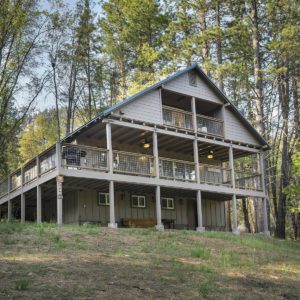
Reserve a home away from home inside Yosemite National Park and close to the Mariposa Grove of Giant Sequoias with The Redwoods In Yosemite.
One of the best places to stay to explore the Mariposa Grove of Giant Sequoias and see the Grizzly Giant is in a private vacation home in Wawona. Be sure to explore the biggest selection of vacation cabins offered by The Redwoods In Yosemite.
Relaxing and private, these fully-equipped rental cabins are conveniently located in the charming community of Wawona. There are many things to do in Wawona itself. Plus, your cabin is inside the park gates, making it easy to explore other parts of Yosemite, as well as the Mariposa Grove.
Many cabins are pet-friendly, some feature spa tubs and all have private decks with BBQ’s and upgraded linens for that ‘home away from home’ experience.
If you’re planning a trip for a group, be sure to also check into the convenient Event Center for a centrally-located place to gather. The Event Center includes the use of the Fireside Room and the large adjacent deck, along with access to state of the art audio and visual equipment and a catering kitchen.

